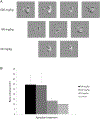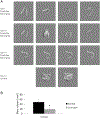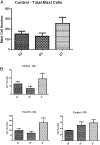Mast cell inhibition as a therapeutic approach in fibrodysplasia ossificans progressiva (FOP)
- PMID: 28851540
- PMCID: PMC7805128
- DOI: 10.1016/j.bone.2017.08.023
Mast cell inhibition as a therapeutic approach in fibrodysplasia ossificans progressiva (FOP)
Abstract
Background: Episodic flare-ups of fibrodysplasia ossificans progressiva (FOP) are characterized clinically by severe, often posttraumatic, connective tissue swelling and intramuscular edema, followed histologically by an intense and highly angiogenic fibroproliferative reaction. This early inflammatory and angiogenic fibroproliferative response is accompanied by the presence of abundant mast cells far in excess of other reported myopathies.
Results: Using an injury-induced, constitutively-active transgenic mouse model of FOP we show that mast cell inhibition by cromolyn, but not aprepitant, results in a dramatic reduction of heterotopic ossification. Cromolyn, but not aprepitant, significantly decreases the total number of mast cells in FOP lesions. Furthermore, cromolyn specifically diminishes the number of degranulating and resting degranulated mast cells in pre-osseous lesions.
Conclusions: This work demonstrates that consideration of FOP as a type of localized mastocytosis may offer new therapeutic interventions for treatment of this devastating condition.
Keywords: ACVR1; Cromolyn; Fibrodyplasia ossificans progressiva (FOP); Heterotopic ossification; Mast cells.
Copyright © 2017 Elsevier Inc. All rights reserved.
Conflict of interest statement
Conflict of interest
The authors declare that they have no competing interests.
Figures







Similar articles
-
Depletion of Mast Cells and Macrophages Impairs Heterotopic Ossification in an Acvr1R206H Mouse Model of Fibrodysplasia Ossificans Progressiva.J Bone Miner Res. 2018 Feb;33(2):269-282. doi: 10.1002/jbmr.3304. Epub 2018 Jan 3. J Bone Miner Res. 2018. PMID: 28986986 Free PMC article.
-
Acute and chronic rapamycin use in patients with Fibrodysplasia Ossificans Progressiva: A report of two cases.Bone. 2018 Apr;109:281-284. doi: 10.1016/j.bone.2017.12.011. Epub 2017 Dec 11. Bone. 2018. PMID: 29241828
-
Characterization of flare-ups and impact of garetosmab in adults with fibrodysplasia ossificans progressiva: a post hoc analysis of the randomized, double-blind, placebo-controlled LUMINA-1 trial.J Bone Miner Res. 2024 Sep 26;39(10):1486-1492. doi: 10.1093/jbmr/zjae140. J Bone Miner Res. 2024. PMID: 39216107 Free PMC article. Clinical Trial.
-
Therapeutic advances for blocking heterotopic ossification in fibrodysplasia ossificans progressiva.Br J Clin Pharmacol. 2019 Jun;85(6):1180-1187. doi: 10.1111/bcp.13823. Epub 2019 Jan 6. Br J Clin Pharmacol. 2019. PMID: 30501012 Free PMC article. Review.
-
A new era for fibrodysplasia ossificans progressiva: a druggable target for the second skeleton.Expert Opin Biol Ther. 2007 May;7(5):705-12. doi: 10.1517/14712598.7.5.705. Expert Opin Biol Ther. 2007. PMID: 17477807 Review.
Cited by
-
Research trends and hotspots of myositis ossificans: a bibliometric analysis from 1993 to 2022.EFORT Open Rev. 2024 Jul 1;9(7):589-599. doi: 10.1530/EOR-23-0207. EFORT Open Rev. 2024. PMID: 38949159 Free PMC article. Review.
-
Injury of Adult Zebrafish Expressing Acvr1lQ204D Does Not Result in Heterotopic Ossification.Zebrafish. 2018 Dec;15(6):536-545. doi: 10.1089/zeb.2018.1611. Epub 2018 Sep 5. Zebrafish. 2018. PMID: 30183553 Free PMC article.
-
Modeling the ACVR1R206H mutation in human skeletal muscle stem cells.Elife. 2021 Nov 10;10:e66107. doi: 10.7554/eLife.66107. Elife. 2021. PMID: 34755602 Free PMC article.
-
Depletion of Mast Cells and Macrophages Impairs Heterotopic Ossification in an Acvr1R206H Mouse Model of Fibrodysplasia Ossificans Progressiva.J Bone Miner Res. 2018 Feb;33(2):269-282. doi: 10.1002/jbmr.3304. Epub 2018 Jan 3. J Bone Miner Res. 2018. PMID: 28986986 Free PMC article.
-
Heterotopic Ossification: A Comprehensive Review.JBMR Plus. 2019 Feb 27;3(4):e10172. doi: 10.1002/jbm4.10172. eCollection 2019 Apr. JBMR Plus. 2019. PMID: 31044187 Free PMC article. Review.
References
-
- Bischoff SC, Role of mast cells in allergic and non-allergic immune responses: comparison of human and murine data, Nat. Rev. Immunol. 7 (2) (2007) 93–104. - PubMed
Publication types
MeSH terms
Substances
Grants and funding
LinkOut - more resources
Full Text Sources
Other Literature Sources
Molecular Biology Databases

